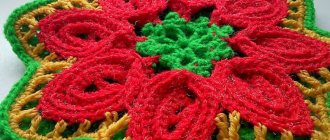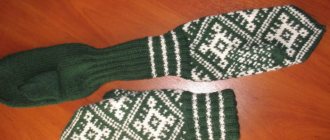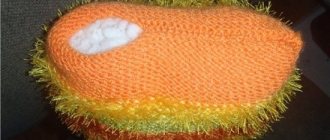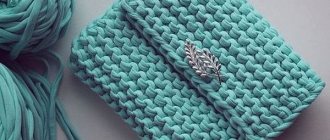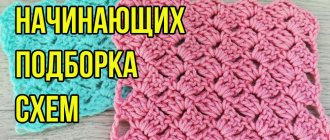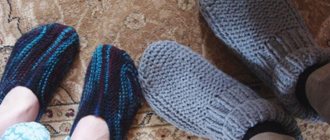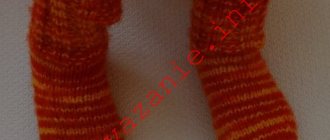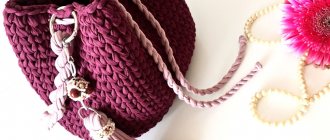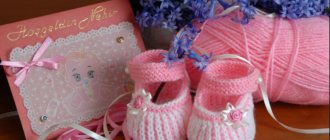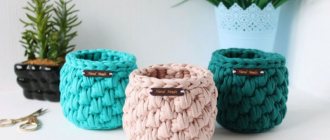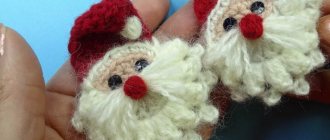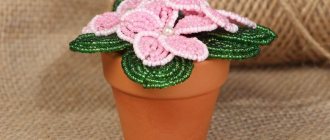01/20/2018 Knitting Share
In the cold season, knitting children's socks with knitting needles is simply necessary. It is so important that the child’s feet are warm. For a year, 2 and 3 years, choose wool yarn or alpaca yarn, with an admixture of artificial fiber, for example, polyamide. When knitting the heel, it would be nice to add a thin bobbin thread. Summer openwork socks are knitted for beginners from cotton yarn. At the end you will find patterns of cats for knitting jacquard.
How to calculate the number of loops for knitting a sock
In order not to start work over and over again, before knitting children's socks with knitting needles, we will calculate the required number of loops. In order for the socks to fit the child perfectly, you need to take into account the height of the leg, the size of the shin and the size of the foot itself.
- There are circumstances when trying on a sock is impossible - then use the formula: X: 3 x 2 = Y, in which X means the shoe size, and Y is the length of the foot. X: 3 x 2 = Y where X is the shoe size and Y is the foot size in centimeters. For children's socks with knitting needles you will need 50 g. yarn.
- If this seems difficult to you, there are tables that indicate how many stitches to cast on according to the knitting density. It is necessary to knit a “tester” - 10/10 cm in order to calculate the required number of loops.
- Another option for determining the number of loops. It is necessary to take 2 measurements of the baby’s legs: the 1st measurement is the circumference of the instep, it is measured with a centimeter at the widest point of the instep. 2nd measurement – leg circumference, measured above the bone. Next, we find the average circumference: plus the circumference of the volume and the circumference of the leg and divide by 2. See so much and do the calculation for the set of p.
- And the last option. Everyone knows that the anatomy of the leg has its own proportions. Look at the size ratio of the leg. You can't go wrong if you cast on the number of stitches on your knitting needles that correspond to the size: (top of the foot + sole = 100%). This is the size you need for the correct set of loops. Next we will knit beautiful socks with a step-by-step master class.
A set of loops in accordance with the anatomy of the leg.
Size chart for different knitting densities.
Materials and tools
Every knitter should have three tools:
- a set of knitting needles;
- scissors;
- yarn.
The work is based on knitting needles. Now on the market they are presented in different quality and cost. The price depends on the material from which they are made. There are: wooden or bamboo, aluminum, steel and acrylic. Next, you need to choose the right shape: knit baby socks using sock knitting needles (on four needles) or circular knitting needles (on two knitting needles).
On a note. You choose the knitting needles yourself according to how you feel. The work will be easier and faster with knitting needles with the smoothest possible surface. The hinges will not cling, nothing prevents sliding. You can choose knitting needles made by Addi.
The function of scissors here is clear - to carefully cut the threads. Let's take a closer look at the choice of yarn.
Socks with a cat pattern
We will knit these original socks step by step with knitting needles for a child aged 3 – 4 years. We will knit on five needles in the simplest “grandmother’s” way. Knitting children's socks is something that is suitable for beginners who are just starting to knit. This simple way to knit baby socks will also come in handy for those who knew but forgot this technique.
Abbreviations: p. - loop, r. – row, l. – front, from. - purl, sp. - knitting needles, inm. - together.
To work you will need:
- 5 double needles, 3 mm thick.
- Yarn – wool with polyamide (150 m/50 g) – 1 skein of gray and 1 skein of blue.
- Black and red thread for the cat's face.
- An eraser at the end of each knitting needle is to prevent the yarn from slipping off the knitting needles.
- Pins or markers.
Table number 1, which helps to knit children's socks.
A 3-4 year old child’s foot corresponds to shoe size 26/27 and the foot size is 16-17 cm. We cast on 44 stitches with gray yarn. We focus on table number 1. We distribute all 44 stitches onto 4 knitting needles - on each knitting needle you will get 11 stitches. We will knit an elastic band first, and then circular rows. Mark the place of transition from one river to another. (between the 1st and 4th sp.) – with a marker. An elastic band can be knitted as in the photo (1 knit/1 knit), but, as a rule, such an elastic band stretches out quickly. Therefore, it is better to tie a 2/2 elastic band. Knitted 10 rubles. with an elastic band and move on to the faces. smooth surface We knit as many r., how high you want to make the socks. In this model there are only 6 r., usually 10 cm. In this place, patterns and patterns with jacquard are usually knitted.
Next, we will knit the heel wall. We will do this on the 1st and 4th sp. facial stitch. We are not touching the 2nd and 3rd spokes yet. We look at table 1: heel wall – 22 r. (44 : 2), heel wall height – 14 r. (4 cm). If you knit the first and last stitches in garter stitch, this will make it easier for you to count p.
Next, you need to tie the bottom of the heel. Divide 22 sts into 3 parts (7;8;7). Mark with markers. We got 7 stitches on both sides, and 8 stitches in the middle. We start with the front row: knit 14. p., k2 together, turn the work over (we do not knit the remaining 6 sts, leave it like that. 2nd r.: 8 p., 2 v. p., turn over (leave 5 p. unknitted). 3rd r. .: k8, k2, turn knitting. Row 4: k8, v2, turn knitting. And so on until there are 8 stitches left on the knitting needle.
Now we have 8 stitches left. Next, we need to cast on as many stitches from the edges onto the knitting needles as we have in table number 1 on both sides (the number of stitches for casting on the side edges of the heel is 11, but we will take a little less - 9 stitches. ). In the place where the tail of the thread sticks out, we pick up 9 sts on the knitting needle and knit them, then we have 11 sts, another 11 sts, and again we pick up 9 sts on the knitting needle, knitting their faces. And here we have circular knitting again. There are currently 48 stitches on the needles.
And in this place it would be good to try on the sock on your foot. If it is too wide, reduce it. If the number of sts suits you, we knit further in the circle, distributing the sts: 12 sts on each knitting needle. The beginning of the circular row is in the middle of the bottom of the heel (mark with a marker). We have 48 stitches on our knitting needles. We knit across a row of 2 knits together. Let's focus on the marker. Knitted 8 r. and decreased 4 p. 44 p. left, on each sp. – 11 p. Next, we begin to make the cat’s ears. Our pattern is 32 stitches, which means we add 12 stitches to the pattern, 6 on each side, and start knitting from the ears, from the 30th row:
To ensure that the long blue thread on the inside doesn’t bother you, make 2 blue balls. Gray yarn: 14 knits. p. gray, 1 person. p. blue, 14 p. gray, 1 p. blue, 14 l. n. gray. 29th r.: 13 l. p. gray, 3 l. n. blue, 12 l. p. gray, 3 l. n. blue, 13 l. n. gray. 28th r.: 12 l. p. gray, 5 l. n. blue, 10 l. p. gray, 5 blue, 12 l. n. gray. 27th r.: 11 l. p. gray, 7 l. n. blue, 8 l. p. gray, 7 l. n. blue, 11 l. n. gray. 26th r.: 10 l. n. gray, 9 blue, 6 gray, 9 blue, 10 gray. 25th r.: 44 l. n. blue.
Then we continue to knit according to the pattern, not forgetting to add 6 stitches on each side.
The length of the foot to the toe is 13.5 cm (see table). We knit according to the pattern up to this point. We reach the little toe. Next we begin to make the toe. We make decreases at the end of every 11 stitches (2 stitches together). So we decrease until 2 stitches remain on the knitting needles. We cut the thread. We pull the end of the thread through these loops. We remove the tail.
The second sock is knitted in the same way, only it starts with blue yarn, with an elastic band.
In the video: how to knit children's socks on 5 knitting needles.
KNITTING! HOW TO KNIT SIMPLE SOCKS FOR BEGINNERS! knitting
What you need for work
First of all, you need to choose suitable knitting needles ; ordinary hosiery knitting needles number 1 are ideal for this. For knitting small sizes, four knitting needles will be enough, and for large socks you will have to take five. To knit baby socks, you also need to choose yarn with a high wool content. There is no need to worry about the socks being itchy, since you will still have to wear them over thin tights.
Of course, such threads are not sold in stores, but they can be purchased from local farmers. The only thing you need to remember: if a child is allergic to wool, then it is better to avoid such threads.
Children's socks on two knitting needles - master class with description
Children's socks on two knitting needles - this master class will be useful for those who do not like to knit on 5 knitting needles. We knit socks on 2 knitting needles, three more knitting needles are auxiliary. Then we sew the product with a needle and native thread. The product corresponds to size 22/23, foot length – 15 cm. Socks are knitted for ages 3 years.
To work you will need:
- Yarn – wool or wool blend – 1 skein 50 g.
- Stocking knitting needles 3.5 mm thick.
- The needle is thick.
We knit the upper part of the sock. We cast on 39 sts and plus 2 edge sts, total - 41 sts. 1st row: edge, k1. p., 1 p., and so on until the end of the r., at the end - the edge. 2nd r.: chrome, 1 p. p., 1 l. etc., and so on until the end, at the end - chrome. And so continue with an elastic band for 28 rows. Next, we make a “tongue”: we knit it at 13 sts, and don’t touch the remaining sts!
1st row: chrome, 26 persons. etc., turn the work around. 2nd row: 13 persons. etc., turn the work around. 3rd row: k13, turn.
And so we knit garter stitch (knit stitches alone) for 34 rows. We got it: 14 sts on the first knitting needle, 13 for the tongue, 14 sts on the second knitting needle.
Next comes the rounding of the heel.
35th r. already without chrome. p.: knit 2 together, knit 9, knit 2 together. 36th r.: all facial. 37th r: 2 vm. persons., 7 persons., 2 vm. persons 38th r: all persons. 39th r: 2 vm. persons., 5 persons., 2 vm. l. Next, we knit the circumference of the sock.
We tied the tongue to the end. We have left on the joint. 7 p.
Next, we will raise (knit) stitches from the sides!
1st r. sock circumference: raise 19 sts along the left side of the “tongue”, knit plus these 19 sts, another 13 sts from the second knitting needle and edge. Knit faces. Turn.
It turns out 7 stitches of “tongue” on a separate needle.
2nd r: chrome, knit 32, plus another 7 p. “tongue” knit. – total 39 p.
Next, we raise (knit) 19 faces. along the right side of the “tongue”, chrome.
In total it turned out to be 71 points plus 2 chrome. (73 p. on the spread).
Then we knit 9 rows of faces.
Next, we make the sole:
1st row: chrome, 2 vm. persons., 28 persons., 2 vm. l., 3 l., 2 vm. l., 3 persons., 2 vm. l., 27 faces., 2 vm. l., chrome. 2nd row: chrome, 66 persons. chrome 3rd row: chrome, 2 vm. l., 26 l., 2 vm. l., 2 l., 2 vm. l., 2 l., 2 vm. l., 26 l., 2 vm. l., chrome. 4th row: chrome, 61 persons, chrome. 5th row: chrome, 2 vm. l., 24 l., 2 vm. l., 1 l., 2 vm. l., 1 l., 2 vm. l., 25 l., 2 vm. l., chrome. 6th row: chrome, 56 l. n., chrome. 7th: 2 vm. l., 22 l., 2 vm. l., 2 vm. l., 24 l., 2 vm. l., chrome. 8th: chrome, 51 l., chrome.
Next, we connect the knitting needles and sew the open loops on the foot with a needle using the same yarn.
Then we sew the top, heel and foot. We hide the end of the thread. Knit another sock.
In the video: an easy way to knit socks for 1-2 years old.
An unusual way to knit children's socks on two knitting needles
A set of loops for forming an instep wedge
After the cup of the first sock is knitted, you need to take a free knitting needle and, from the side where the loops that did not participate in the formation of the heel end, cast on 12 (13, 14) loops along the edge of the heel wall.
Then unfold the work and knit the loops cast on along the edge of the heel with facial loops.
Move the first sock to the middle of the fishing line. Repeat all steps starting from * for the 2nd sock.
Pull out the line, change the needles and knit 22 (24, 26) knit stitches from the front side of the second sock.
Then knit all the stitches on the front side of the first sock.
** Using a free needle, cast on 12 (13, 14) stitches in the direction from the cup loops along the edge of the heel wall. Unfold the work and knit the cast-on stitches with knit stitches. After which the loops of the foot will close. The sock can be continued to be knitted in the round.
Knit the remaining stitches at the back of the sock. There should be a total of 32 (34, 36) stitches on the back of the sock.
Repeat from ** for the second sock.
Knit openwork socks for girls
Openwork socks are knitted for ages 6-8 years with medium-thick cotton yarn on 5 3 mm needles. Foot length – 20 cm. Size 30-31. We will knit openwork socks in the round. To make it easier for you to knit, check table number 1 in the first master class.
We cast on 48 sts on 2 knitting needles, distribute them across 4 knitting needles (12 sts each) and knit further in the round:
1st r.: entire r. – facial. 2nd row: purl. 3rd: persons. 4th: purl. 5th, 6th, 7th - persons. 8th: purl. 9th: persons. 10th: purl. 11th and 12th: knit. 13th we make small holes for the laces: chrome, yarn over, knit 2 together, yarn over, 2 ins. l., and so on until the end of the river. 14th row: repeat the pattern from the 1st to the 12th row
Next, we knit the heel: 24 sts. Knit 7 cm in height (16 rows) on two sp., the remaining 2 sp. don't touch. 17th row: divide the same 24 sts of the heel into 3 parts (7;10;7) sts. Knit only the middle 10 sts. Start with the front row. So: 6 l., 2 vm. l., 10 l., 2 vm. l., 6 l. Rotate the work. 18th: 5 p., 2 in. purl, knit 10, inm 2 out., 5 out.
And so on until it remains on sp. 10 central points
Next, we raise the side stitches on one side and the other (see the first master class). You need to raise 12 sts on each side. Distribute the sts like this: 28 sts on 2 sps, 26 sts on the remaining 2 sps. 28 sts are our rapport (see diagram), on these sts we will knit only the pattern (top of the sock).
On the remaining 2 bedrooms. Gradually decrease 6 extra stitches so that 48 stitches remain in the circle. Work 16 cm to the toe and begin decreasing. Decreases should be done like this: divide the entire canvas into 4 parts and do 2 cm after each. (11 p., 2 in., 11 p., 2 in., and so on) knit the toe to the end. We pull the thread through the last stitches and fasten it inside. Openwork socks are ready.
Forming an instep wedge
In order to form a wedge of the instep, it is necessary to reduce the additional loops formed on the underside of the toe. We will decrease one stitch at a time at the beginning and end of the foot until the number of stitches on the top and bottom sides of the foot is the same. Decreases are performed with facial loops tilted to the left and tilted to the right.
Description given for the underside of the sock. The stitches on the top side of the sock are knitted without decreasing.
1st row: 2 knit stitches together with a slant to the left, 28 (30, 32) knit stitches, 2 knit stitches together with a slant to the right.
Row 2: 30 (32, 34) knit stitches.
3rd row: 2 knit stitches together with a slant to the left, 26 (28, 30) knit stitches, 2 knit stitches together with a slant to the right.
Row 4: 28 (30, 32) knit stitches.
Row 5: 2 knit stitches together with a slant to the left, 24 (26, 28) knit stitches, 2 knit stitches together with a slant to the right.
Row 6: 26 (28, 30) knit stitches.
Row 7: 2 knit stitches together with a slant to the left, 22 (24, 26) knit stitches, 2 knit stitches together with a slant to the right.
Row 8: 24 (26, 28) knit stitches.
Row 9: 2 knit stitches together with a slant to the left, 20 (22, 24) knit stitches, 2 knit stitches together with a slant to the right.
Row 10: 22 (24, 26) knit stitches.
After the 10th row, the formation of the instep wedge is completed.
In order to complete the foot, you need to knit 33 stitches (41, 49 rows).
Elastic cuff
For these socks, you need to take 135 m thick acrylic yarn by 50 g and number 3 knitting needles. They are knitted from the cuff to the toe, so it is best to start with a cross cast on, which will allow the elastic to stretch.
The back of the cuff is knitted first.
To start, cast on 20 stitches. Start knitting the cuff with an elastic band 1 x 1 (k1, p1) or 2 x 2 (k2, p2). Knit 16 rows in this way.
The next 16 rows need to be done in stocking stitch - all front rows are knitted with knit stitches, and purl rows with purl stitches.
32 rows is the full height of the cuff. It can be increased or decreased if desired.
Seam method
For socks for 37 rubles. legs, cast on 49 sts and knit 30-35 r. with an elastic band depending on the desired length of the boot. Mark the middle stitch with a crochet staple; through the row you will make five of it in this way - l., nak., l., nak., l. Knit inside out. Having reached 97 p., perform 6 r. facial. Knit the sole from 13 stitches. Sew at the back.
Tip: join the remaining 6 loops three into one and knit. Cut the thread.
Please note: pull out the loops more when closing, they may not stretch or shrink during washing, and then it will be problematic to put on the sock.
Knitted footwear
Those who like to relax at home in comfortable shoes will love knitted sock soles. Take skeins of two colors 100 g / 240 m. Knitting density 10 cm = 20 loops.
Life hack: knit the bottom with double thread, preferably strong and soft yarn.
Short socks should fit snugly on your feet and not slip off. You can make them without a single seam. Cast on 5 loops with a light-colored thread. Knit a knit stitch between two edge stitches. On the next row, add 2 sts between knit stitches and continue adding.
Always knit yarn overs purlwise. Knit the top with an elastic band one after another. The result should be 73 stitches; they are divided into three parts, leaving the middle two fingers shorter than the ends. Connect the toe with the side loops until you have knitted them all.
Then knit the sides with the sole, casting on 12 stitches from each. Knit straight, knitting 5 stitches from the edges. When you have 30 rubles, make a heel and crochet the edge. The hook needs to be the same size.
